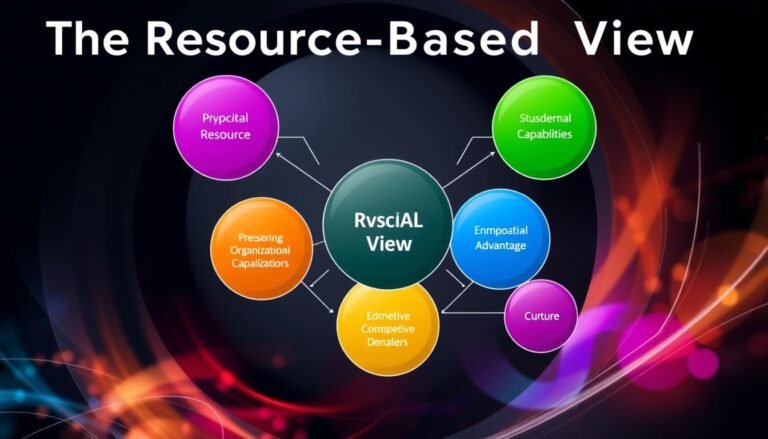Core Competencies Theory: Key Business Insights
Ever wondered why some companies do better than others? It’s all about mastering the Core Competencies Theory. In today’s complex markets, knowing and using your key strengths is crucial. This article will show how focusing on these unique skills sets companies apart. It also helps them improve their business strategy for better efficiency and success over time.
Key Takeaways
- Core competencies help companies stand out in the market.
- They include important skills, knowledge, and resources needed for success.
- Understanding these competencies can boost a brand’s image and market share.
- Experts’ competency models highlight trends in performance.
- Successful companies show how using core competencies makes a big difference.
- Developing these competencies helps lower market risks.
Understanding Core Competencies
Today, companies aim to find and use their core competencies to get ahead in the market. Knowing what these are is key for managers in many fields. These skills give companies a strong base that helps them innovate, make smart choices, and do better overall.
Definition and Importance
C. K. Prahalad and Gary Hamel first talked about core competencies in a 1990 article. They said these are special skills that set companies apart. These skills must add a lot of value for customers and be hard for others to copy. This uniqueness lets companies like McDonald’s and Southwest Airlines focus on what they do best, shaping their strategies.
Knowing the value of these skills helps executives see what’s coming in their industry. This helps them stay flexible and ready for new changes.
Characteristics of Core Competencies
What makes core competencies so important? They need to last, meet customer needs, and change as needed. For example, Rackspace values great customer service as a key skill. This affects who they hire and their overall strategy. Companies like 3M and Accenture stand out because of their innovative skills.
To make these points clear, here’s a table that lists key parts of core competencies. It shows how these skills help with making products and services, get ahead in the market, and grow through partnerships.
| Core Competency | Key Elements | Impact on Business |
|---|---|---|
| Communication Networks | Understanding of various communication technologies | Improves operational efficiency and customer engagement |
| Innovation | Expertise in creating new technologies and solutions | Drives product development and market leadership |
| Quality Assurance | Systems for ensuring product consistency and reliability | Builds customer trust and loyalty |
Core Competencies Theory and Competitive Advantage
Core competencies are key to a business’s success. They help companies innovate and work more efficiently. It’s important to recognize and grow these strengths to stay ahead in the market.
How Core Competencies Drive Success
Companies that use their core competencies well have a clear path to success. They focus on unique skills that make them stand out. For example, these competencies help make products that customers love and keep costs low.
Studies also show that successful companies use their core competencies to form strategic partnerships. This boosts their market presence and improves their work with others.
Examples of Successful Companies
Real-world examples show how companies have done well by using their core competencies.
- Apple: Apple’s innovative design and strong brand give it a big edge. This creates a loyal customer base that keeps sales up.
- Dell: Dell uses a Just-in-Time inventory system to cut costs and offer custom service to corporate clients. This has made it a leader in the PC market.
- Walmart: Walmart’s focus on efficient supply chains makes it a leader in logistics. This is a key strength for the company.
As companies improve their competencies, they get better at making money and entering new markets. This keeps them ahead in the long run.
Key Components of a Competency Framework
A competency framework is key for spotting the skills needed for success in an organization. It helps match the workforce with the company’s goals. This ensures both employees and the company do well in a tough market.
Identifying Key Competencies
Identifying key skills means looking at both basic and job-specific abilities. Core skills are needed by all employees. Job-specific skills are for certain roles. Adding skills like adaptability makes the framework better.
Getting input from different people makes sure the framework meets the company’s goals. It also makes things clear for everyone.
The Role of Skills Assessment in Organizations
Skills assessment is vital in a competency framework. It checks how well employees can do their jobs and finds areas that need work. This helps improve talent management, like hiring, keeping good people, and planning for the future.
Using a competency framework for assessments helps create better training and growth plans. This boosts performance and career growth for employees.
Core Competencies Theory in Organizational Strategy
Putting core competencies at the heart of an organizational strategy is key for businesses to reach their goals. It’s important to match competencies with business aims for a strong framework that boosts growth and efficiency. Identifying core competencies helps companies use their strengths to encourage innovation and productivity.
Aligning Core Competencies with Business Goals
Aligning core competencies with business goals boosts operational success. Companies need to pinpoint their unique strengths as a base for competitive edges. For example, Walt Disney shines in animation and storytelling, making these crucial to their strategy. By focusing sharply, companies improve how they use resources and employee roles, making sure everyone helps meet the big goals.
Integrating Core Competencies Across Departments
Bringing core competencies together across departments creates a team spirit vital for reaching goals. Sharing skills and resources among teams builds a cohesive culture that boosts performance. This approach not only spreads knowledge but also sparks innovation as teams use each other’s strengths. A strategy that values these competencies can greatly improve efficiency and lead to success in tough markets.
The Role of Talent Management in Core Competencies
Talent management is key to making core competencies shine. Companies that focus on growing their employees do better. When they encourage learning, workers can get better at their jobs and help the company reach its goals.
Developing Employees’ Core Competencies
Helping employees grow makes them and the company do better. Top workers can be much more productive with the right support. When companies work on improving skills, they often hit their targets fully.
Learning new things keeps employees wanted and needed in a changing job world.
Recruiting for Core Competencies
Choosing the right skills for the job sets up a team for success. The U.S. Department of Labor says bad hiring can cost a lot of money. By picking the right skills early, companies avoid these losses.
Using talent management and smart hiring helps companies face the future. Building a team with the right skills gives a lasting edge in the market.
Performance Evaluation and Core Competencies
Using performance evaluation and core competencies is a strong way to boost employee performance and improve the organization. It matches employees’ skills with the company’s goals. This makes it clear what is expected and how they help the company.
Assessing Employee Performance Based on Core Competencies
Organizations use frameworks that focus on core competencies to check employee performance. This method helps see how well employees meet their job needs and fit with the company’s culture. It also makes giving feedback clear and reduces confusion.
Employees know exactly what they will be judged on. This encourages them to be responsible and keep growing.
Utilizing Competency-Based Assessments for Growth
Competency assessments help not just in checking how well employees do their jobs but also in helping them grow. They spot where employees need more skills or knowledge. Then, training can be given to fill those gaps.
This approach boosts the company’s performance and makes employees happier at work. For growth, it’s key to keep assessments simple and focused. Using feedback from different sources helps give employees a full picture of their performance.
Core Competencies Theory: Implementing in Your Organization
Using core competencies makes an organization perform better and stand out. It focuses on what makes a company unique. This helps in dealing with market challenges. The first step is to find and improve these core competencies by following a detailed plan.
Steps to Identify and Develop Core Competencies
To find and boost core competencies, companies can take these steps:
- Get input from everyone through surveys and focus groups.
- Look at what the company can do well, using its people and resources.
- Study the competition to see where you can be different.
- Use what makes your company special to offer more value to customers.
- Keep investing in training to make these competencies even stronger.
Creating an Organizational Roadmap
An organizational roadmap is a strategic plan that links core competencies with business goals. It keeps everyone in the company working together. A good roadmap has:
- Clear Milestones: Set goals to track progress in building core competencies.
- Accountability: Give teams or people specific tasks to improve competencies.
- Regular Review: Check progress often and adjust as needed due to market changes.
- Integration Across Departments: Make sure all departments know and work together to support core competencies.
Adding these parts to your strategy helps your company grow in a structured way. It makes sure core competencies are part of daily work and key to the company’s goals. This approach helps improve continuously and use strengths well in the market.
| Core Competency | Benefits | Industries Impacted |
|---|---|---|
| Operational Efficiency | Cost reduction, faster service | Fast Food, Airlines |
| Innovative Design | Market distinction, customer loyalty | Technology, Consumer Goods |
| Customer Service Excellence | Enhanced customer satisfaction, brand loyalty | Hospitality, Retail |
| Strong Branding | Increased market presence, trust | Luxury Goods, Automotive |
Using a clear roadmap for core competencies helps a company grow and stay adaptable. This keeps the organization competitive in a changing market.
Conclusion
The Core Competencies Theory is key for businesses wanting to stand out in today’s fast world. C.K. Prahalad and Gary Hamel first shared this idea in 1990. They showed how important it is to know and grow your core strengths for a strong business plan.
This theory talks about using a shared knowledge base to better use resources, boost your brand, and work more effectively. It also highlights the need for a human focus. This approach helps in controlling strategy and getting employees to work together better. This leads to new ideas and a mix of different viewpoints.
But, there are challenges like becoming too set in your ways or missing out on key skills. It’s vital to keep checking and managing your core strengths as the market changes. This way, you can keep doing well and stay ahead.
By using these ideas in their plans, companies can handle today’s complex competition. They can also get ready for growth and change over time. Following the Core Competencies Theory helps businesses use their strengths well and aim for success in the future.
Source Links
- Core Competencies
- Core Competencies in Business: Finding a Competitive Advantage
- The importance of core competencies and what they mean for business growth?
- Microsoft Word – Lockwood_CoreCompetencies_2010.docx
- Core competency
- Understanding the Impact of Competitive Advantage and Core Competency on Regional Tourism Revitalization: Empirical Evidence in Taiwan
- Link Between Core Competency and Competitive Advantage – MBA Knowledge Base
- Core Technological Competence and Competitive Advantage: A Study on Chinese High-Tech SMEs
- What is a Competency Framework and How Do You Develop One?
- How to Develop a Leadership Competency Framework: Step-by-Step Guide
- Competency Model: Complete Guide With Examples | TalentCards
- Core Competency Theory of Strategy
- Strategic core competencies for business and individuals
- Core Competence Model (Hamel and Prahalad)
- What is talent management?
- Competence development as a means of HR management in the field of social work
- Applying core and leadership competencies to drive employee and customer engagement – HRD
- Competency Models and Performance Management — Getting It Right – Performance Management Consultants
- A Guide to Developing a Competency-Based Performance Management System
- Core Competencies: What They Are and How They Lead to Success
- Core competencies for implementation practice
- Theorizing the Concept of Core Competencies: An Integrative Model beyond Identification
- Cores & Competencies
- Proposed Core Competencies and Empirical Validation Procedure in Competency Modeling: Confirmation and Classification







